The sludge and water are then removed from the lagoon by vacuuming and / or
pumping it to the onsite sand drying bed. The sludge remains on the drying bed
for a period of 2 to 3 years. This sludge dries to a solids content of between
60 to 80 percent.
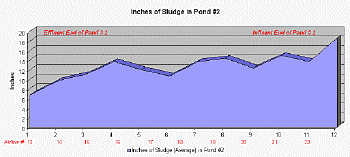
click graph for larger size
Sludge removal at the Millinocket
Wastewater Treatment Facility has occurred 7 times in the plant's 22-year
history. Most recently, Lagoon #2 was dewatered in the summer of 1999 and
removal operations commenced. The determination was made to remove the
accumulated biomass in Lagoon #2 in 1999 after the three-facultative lagoons had
been sampled for blanket depth.
Sludge Removal From Lagoon #2
Summer of 1999

The lagoon was taken out of the normal
sequence of operation on April 26th. Influent flow was routed from Lagoon #1 to
Lagoon #3. Several airlines remained on to allow the bacteria to utilize any
organics, which may have been left in the lagoon as well as to continue the
aerobic process. Dissolved Oxygen residuals were monitored and used as an
indicator to ensure the remaining organics were consumed.
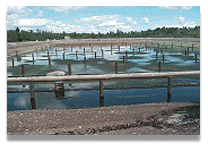
The dewatering process of Lagoon #2 began on July 12th. A Gorman Rupp gasoline
Ford pump with a 6 inch suction and discharge was utilized to pump the
wastewater back into Lagoon #1. This also provided for further treatment of the
water. The pump was operated between 10 to 12 hours per day. It was noticed that
the sludge was being drawn out of the lagoon so pumping was halted on July 25th
with approximately 1 foot of water left in the lagoon. Costs for fuel for the
pump was approximately $700.00 for 897 gallons.

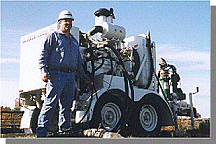
On August 2nd Walker Industrial
Services arrived on site to begin the sludge removal process. A two-man crew,
pump operator and small tractor operator, worked removing the material from the
625 foot long by 325 wide lagoon from sun up to sun down, approximately 14 hours
per day. The sludge was pumped (6 inch discharge piping) at an average of 1,100
gallons per minute to the on site sand drying bed. The pump has the capability
of 2,000 gpm on shorter discharge runs.
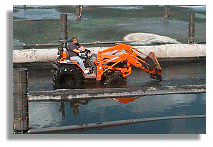
On August 6th, the project was 95%
complete and the sludge pumping process was halted. Sludge remained behind the
effluent baffle chamber of the lagoon at this time. The pumping distance at this
end of the lagoon was in excess of 750 feet and the efficiency of the
hydraulically powered pump was drastically reduced at this distance.
The material left was removed several days later by utilizing a high powered
vacuum truck provided by the contractor. The truck, with an 8-inch suction line
capability, drew the sludge out then transported the material to the sand drying
bed for off loading. This particular truck, manufactured by Guzzler and sold at
a cost of around $200,000, can vacuum sludges from as far as 1,000 feet away.
Thirteen loads of sludge were removed from behind this area.

The sludge resides on the beds for a period of 2 to 3 years in which the
air-drying process, a Class B pathogen reduction process, occurs.
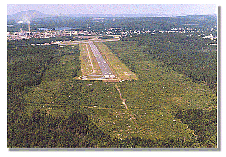 After drying and the appropriate analysis performed to comply with state and
federal regulations, the sludge is removed from the surface of the drying bed
and piled into one spot, thus still remaining on the bed. After calculating the
agronomic rate, the applicable amounts of sludge is loaded onto a dump truck
with a G.I. sander body. The sludge is then transported to the Municipal Airport
(approximately 1/2 mile away) for spreading on the safety strips of the
east-west runway.
After drying and the appropriate analysis performed to comply with state and
federal regulations, the sludge is removed from the surface of the drying bed
and piled into one spot, thus still remaining on the bed. After calculating the
agronomic rate, the applicable amounts of sludge is loaded onto a dump truck
with a G.I. sander body. The sludge is then transported to the Municipal Airport
(approximately 1/2 mile away) for spreading on the safety strips of the
east-west runway.
Once the agronomic rate is met on the 21-acre land spread site, spreading is
halted. The remaining unspread sludge remains on the drying bed, continually
undergoing the air drying treatment process, until it can be utilized during the
next spreading season. Allowing the sludge to remain on the drying bed
eliminates the need for storage accommodations.
The treated biosolids are used as a soil and fertilizer amendment on the safety
strips of the east-west runway. The limiting factor for biosolids spreading is
nitrogen content. Grasses, lichens, and some mosses grow naturally on the safety
strips.
Because the site is regulated by the municipal airport, access to the spread
area can easily be restricted to public contact for 30 days after the
application of stabilized biosolids.

